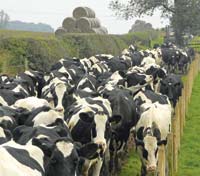NVZs could see end to small time farmers

More dairy farmers than first thought may be forced out by new NVZ rules, leaving many unsure of the future. Sarah Trickett meets a father and son in a dilemma
Declining milk prices, an ageing population of dairy farmers and the need to invest in slurry storage before 2012, leaves many questioning their future in the industry. For West Sussex father and son duo, Harold and Tom Turner, being forced out by the growing red tape burden is becoming a reality.
But it’s not the paperwork that’s the problem, despite the fact that it’s repeated several times under different schemes. Rather, it’s the inability to comply with the new NVZ rules brought in this year that is the issue for the Turners, who milk 75 high-yielding Holstein Friesian cows alongside 100 youngstock over 265 acres.
Already passing two inspections since being brought into the NVZ in 2002 and already well within the 170kg/ha N limit, Harold Turner says he didn’t have any concerns with the previous NVZ legislation. But the new requirement to store slurry for a five-month closed period over winter is a big issue.
“We calculated we would need to double storage capacity to hold just under 500,000t of slurry produced in the five-month closed period and this would cost in excess of £50,000,” he says.
But physical limitations at Lodge Farm, Hassocks, restrict installing new slurry storage, with the farm being hemmed in by main roads and tributaries. “We could pump slurry to a lagoon when placed in a nearby field, but most our fields have streams going through them, which would restrict us.”
But with a three-year grace window to work out what to do before 2012, the Turners say they have only three options. Spend money and add storage is one, but with physical and financial limitations this probably isn’t possible. The second would be to reduce cow numbers. But, with only 75 cows, this also wouldn’t be viable. The third would be to leave the industry altogether.
Things aren’t looking good, says Mr Turner. “We’ve looked into slurry separators, but the physical limitation is a problem. We also considered putting a lid on the slurry store to stop rainfall entering, and although this would reduce the level by 30in, it’s far from enough.”
For a farm that’s been in the family for four generations, it’s not for the want of trying to stay in the industry. Tom Turner has attended several DEFRA-organised days on NVZs to keep on top of legislation and paperwork.
“The meetings told me what I need to know, and keeping on top of record keeping and calculating limits hasn’t been too hard,” he says. “The help is out there; its just using it. Admittedly, for those just being brought into an NVZ zone this year, inputing data such as soil analysis, rainfall and number of animals can be a chore, but using computer programs really helps.”
Although the Turners face some difficult decisions, Yara‘s Ian Matts, says farmers in the same situation shouldn’t just bury their heads and hope it goes away. “The legislation is here to stay. Doing the sums, such as manure storage requirements and whole-farm N limit, isn’t hard, but it’s acting on the sums that’s difficult.
“People need to react because when they don’t, they risk losing money from SFP. Key dates farmers must be aware of are 30 April each year, which is the time storage calculations must be in place. The second is 1 January 2010, by which date a risk map must be in place outlining watercourses, soil types, etc,” says Mr Matts.
Gathering information is time consuming, which is why it’s important to get it right. Yara’s five-point plan can help identify what information to record for the livestock manure limit, storage of manures, planning nitrogen use, the NMAX limit (pdf) and also the organic manure risk map.
But as the Turners have never had a problem passing NVZ inspections, this still doesn’t help them. Harold Turner, says the next stage will be to seek advice from an independent consultant. “The dilemma won’t go away; we can’t budget where we are going, as milk prices keep being cut and this new regulation will inevitably see more leaving dairy production, with us possibly being one of them.”
